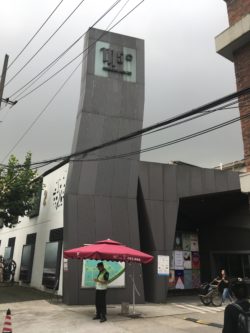Ghost in M50 Host
Popular performance for new urban audience, reconnecting M50 creative cluster with Shanghai all-female yueju (2018-2021) is an AHRC Newton Fund project, examining the missing information of the female textile workers and their theatrical form Shanghai Yueju in today’s textile factory turned creative clusters. In 2020 a field research took place at M50, no information on site about female textile workers, China’s first female working class; few has heard of Shanghai Yueju and no one knows the link between the female textile workers and Shanghai Yueju as the first urban working class theatrical form, sponsored and developed by the female textile workers. This is the background of our project Ghost in M50 Host, jointly led by Shanghai Theatre Academy and Leeds University UK.
M50 is a 23,000 square metre block standing adjacent to Suzhou Creek, which once marked the boundary of Shanghai’s International Settlement. In 1933 a cotton warehouse stood on the site. This was purchased in 1937 by a businessman from Tsingtao who, with undetermined partners, formed the British Xinhe Yarn Company which built a British cotton mill on the site. This mill was equipped with British machinery and went into production in April 1938. In 1939 there were 3000 spindles, 200 looms and around 1000 workers employed on the site. In 1940 it changed hands, becoming a Chinese owned business and in 1941 the Japanese forces took over management of the mill. In 1944 the Zhou family purchased the site and, following the formation of the Peoples Republic of China in 1949 it was renamed the Xinhe Cotton Slub Factory. It changed its name in 1951 to the Xinhe Cotton Spinning Factory and again in 1961 to the Xinhe Woollen Spinning Factory. In 1966 it became the Shanghai No.12 Woollen Spinning Factory and in 1994 it was once again renamed as the Shanghai Chunming Slub Corporation, the name it retained until its closure in 1999 (DAtrans, 2008).
In 1998 The Shanghai Municipal Government had commenced the Suzhou Creek Rehabilitation Project, improving the quality of the heavily polluted waterway and making way for new housing development projects. In 1999 the Factory closed its gates, with all workers made redundant apart from around 20 staff that were kept on for maintenance and cleaning. Over its lifetime the site was an integral part of Shanghai’s textile industry and home and workplace to thousands of female textile workers, who formed China’s first female working class and would be entertained day and night by their adopted All-female Yueju.
Almost overnight, these women were made redundant and dispersed across the city through redeployment programmes and rehousing developments, their work and community spirit in tatters. To maintain some income to the site, units were leased to a gathering group of artists who were entering Shanghai as it transformed through industrial to post-industrial transition leading to the development of Shanghai service industries and Chinese Cultural and Creative Industries. However, in the early 2000s the site was designated for demolition with the Tian’an Group contracted to replace it with high rise accommodation. The resident artists lobbied the government and were fortunate that the SARS pandemic halted demolition work, allowing them time to develop their preservation argument around the historical importance of the Moganshan block. They were eventually successful and the redevelopment was cancelled.
 In 2002 the site opened as the Shanghai Chunming Metropolitan Industrial Park. In 2003 it was declared a protected site under Shanghai’s regulations on the preservation of Excellent Historic Architecture. It was renamed as the Chunming Art Industrial Park in 2004 and thereafter in 2005 it became known as the M50 Creative Park, or simply M50.
In 2002 the site opened as the Shanghai Chunming Metropolitan Industrial Park. In 2003 it was declared a protected site under Shanghai’s regulations on the preservation of Excellent Historic Architecture. It was renamed as the Chunming Art Industrial Park in 2004 and thereafter in 2005 it became known as the M50 Creative Park, or simply M50.
As M50 became increasingly famous as a Shanghai Arts Cluster, rental rates for the units inevitably increased from the original 3y/sqm per day to ten times the amount. Apart from the rising rent the artists themselves began to reject the commercialized atmosphere and many left, making way increasingly for bars and restaurants and international art salons creating a high-class market and tourist destination.
Across the street from M50, at the entrance of Shanghai Textile Museum, is a statue of a female figure with one of her arms broken whilst reaching to the sky with the other. The inscription below reads: Zhuangzhi Duanbi or ‘the martyr breaking one arm to survive’. Director Jiang Guorong, curator of Shanghai Textile Museum, described the painful process of post-industrial transformation as follows:
‘SOE was no longer working and it became the main burden of Shanghai economic transition – first space, second staff. Where the Pearl Tower stands today, the tripod used to be three textile factories. If they were not demolished, Shanghai could not be redesigned. In the early 1990s, there were 550,000 female textile workers, we had to shed them. Today, M50 creative park has only 20 full time employees, but we (Textile Bureau) are still paying around 400,000 pensioners. For Shanghai’s post-industrial transition, China’s Mother Industry, the Textile Industry and its female workers sacrificed themselves’ (Jiang 2020).
Read The Missing ICH in Shanghai CCI for full information.
Also see the follow on AHRC awarded research Song of the Female Textile Workers (2020-2021) and Song: The Future (2021-2022).
